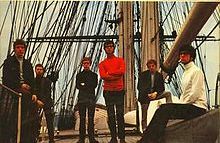A Lifetime ago
Here, out of the blue, is something of historical importance: a piece of film showing Tony Williams’ Lifetime — with Larry Young, John McLaughlin and Jack Bruce — in Bremen, recording for the popular Beat Club TV show during their European tour in late 1970 but never broadcast. This nine-minute extract from that 30-minute performance, which appeared on the programme’s YouTube channel this week, is the only filmed record of the existence of one of the key bands of its decade.
It’s particularly important to me since I saw them twice that year, and it provides evidence, up to a point, of what I’ve been saying ever since. They were extraordinary both times, but the second appearance — at the Marquee on Tuesday 6 October — still lives in the memory as the most electrifying gig I’ve ever attended.
The first time was at Ungano’s, a club on West 70th Street in NYC, where they spent most of August, having done a week at Slugs’ Saloon in the East Village in April and then played concerts in Pennsylvania, Detroit, Cincinnati and elsewhere. They were still a three-piece, just drums, organ and guitar, as they had been on Emergency!, their remarkable debut album, and already they were staggeringly different from anything else around. (One thing I remember about that night is Miles Davis leaning against the bar, wearing a tan patchwork suede suit, listening hard. Outside his silver Lamborghini Miura was parked at the kerb.)
The next day I went to interview Tony at the office of Polydor, his record company. The conversation was not productive. He was reading the New York Times while I asked my questions, and he carried on reading while he gave his answers in surly monosyllables. I don’t think I even wrote it up. His manager later conveyed his apologies. As it happened, I didn’t mind. A lot of the younger musicians who’d worked with Miles in the ’60s had picked his refusal to be ingratiating, either with audiences or journalists. Being cool was the priority. That was kind of all right with me.
And anyway I’d more or less worshipped Tony Williams since he’d joined Miles in 1963, aged 17. He was 15 months older than me, and I was trying to be a drummer at the time. To have someone of just about my age joining Miles was mindblowing. The dimension of his genius — and genius is what it was — somehow softened the blow when I decided that I wasn’t going to make a career of it. I was happy just to listen to him, whatever he did and whoever he did it with. And however he chose to conduct his public relations, which was really not important.
Bruce had joined to make it a quartet by the time they arrived in Europe for two months later for a 40-date tour. The Marquee was the third of those dates; they’d already played at Lancaster University and the Roadhouse in Dagenham. I stood there with Robert Fripp among the audience of about 200 as they played and he was as blown away as I was by the cascades and tidal waves of sound they produced. That’s what the Beat Club clip, magnificent though it is, doesn’t capture: it gets the complexity of the music but not the intensity, which had less to do with volume — although they were very loud — than with intention. The overriding sensation was that they were on a collective journey of discovery, there and then.
Larry Young was the least known of the four to a British rock audience, but in a way his playing defined the music that night. His Blue Note albums — Into Somethin’ and Unity — had shown that he had a very different approach to the Hammond organ from Jimmy Smith, Jack McDuff or John Patton. He brought the instrument into the sphere of the New Thing. But with Lifetime he took it somewhere completely different, into a realm of almost pure texture (although that’s not an adequate word).
I’m indebted to the drummer Vinnie Sperrazza for teasing out, in his excellent Chronicles blog, the identity of the snatches of four themes heard in the clip: three McLaughlin pieces, “Devotion” and two that he would later record with the Mahavishnu Orchestra,”Trilogy” and “The Dance of Maya”; and the Jack Bruce/Pete Brown “Smiles and Grins”, which would appear on Jack’s solo album Harmony Row a year later. There’s a lot of 7/4 in there.
For me, this was the band of the era. To a far greater extent than Weather Report, Return to Forever, Headhunters or Mahavishnu, they realised the promise of In a Silent Way and Bitches Brew. Only Hendrix, at his very best, could match them. And they were together not even a year. It’s painful to think of what they might have gone on to achieve. But sometimes, even now, you can hear a band clearly marked by their influence, and it still sounds like the future.


 When a friend asked me this week to name the most memorable gig I’ve ever attended, I could answer him in a heartbeat: the Tony Williams Lifetime at the Marquee on October 6, 1970. Nothing has ever felt more like the future exploding in the audience’s ears.
When a friend asked me this week to name the most memorable gig I’ve ever attended, I could answer him in a heartbeat: the Tony Williams Lifetime at the Marquee on October 6, 1970. Nothing has ever felt more like the future exploding in the audience’s ears.
